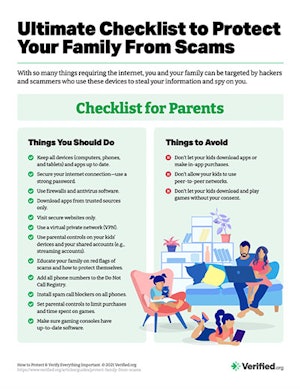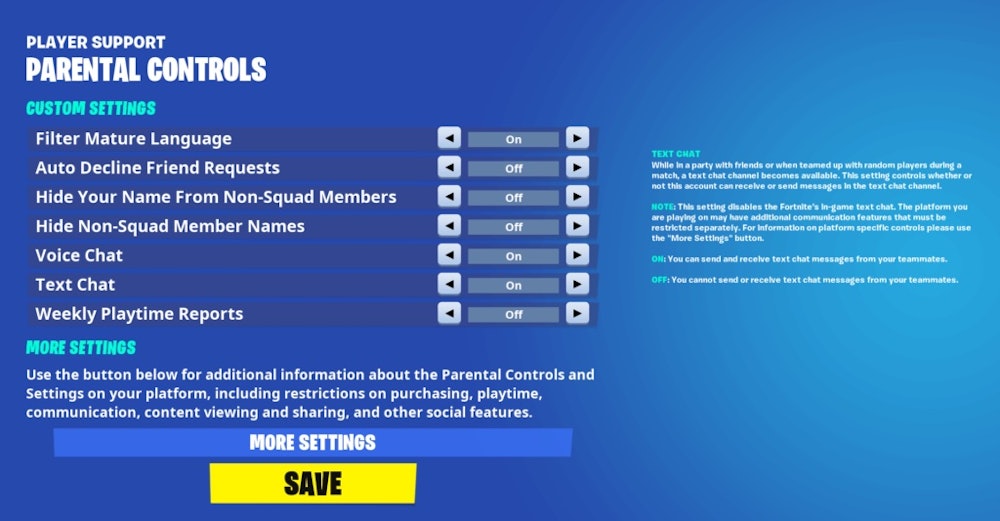- What is Fortnite?
- How Fortnite Could Be Dangerous
- Fortnite Parental Controls
- Common Scams Targeting Fortnite Players
- How to Keep Your Kids Safe on Fortnite
- Frequently Asked Questions
If you're a parent with young children, you've probably at least heard of Fortnite. It's only the most popular game in the world right now, after all. But you may be wondering whether Fortnite is safe for kids or not?
With its bright colors and cartoonish characters, the Fortnite game may seem like harmless fun. But there are some things you should know about the popular video game before you let your kids play it.
Keep reading to learn more about Fortnite and whether or not it's an age-appropriate game for kids.
Download Our Handy Online Safety Checklist
Kids are spending more and more time online, whether they're playing games like Fortnite or Roblox, doing homework, or just watching a show. Learn what you can do to protect them from the many dangers there are online.
Download Checklist (141 KB PDF)
What is Fortnite?
Fortnite is a battle royale-style video game that was first launched in 2017. This is a popular and free game, but players can make in-app purchases (e.g., for in-game cosmetics) with real money. These cosmetic items do not affect gameplay and are purely for aesthetic purposes. There are three versions of the game:
- Battle Royale
- Save the World
- Party Royale
The game is rated T (Teen) by the Entertainment Software Rating Board (ESRB), which means it's suitable for children 13 years and up. However, many parents are concerned about the game's violent nature (as with all violent first-person shooters) and whether it's appropriate for younger children.
Save the World Mode
Save the World is a cooperative shooter-survival game, while Battle Royale is a free-to-play battle royale game where 100 players compete against each other in a last-man-standing deathmatch.
In Save the World, players work together to survive waves of zombies. The game is less popular than Battle Royale, but it is still frequently played.
Battle Royale
Battle Royale is the most popular mode and is the focus of this article. If your child has been asking to play Fortnite, they're probably referring to this mode that mimics the Hunger Games.
In Battle Royale, you can play games solo, in a duo, or a squad (4 players). The aim of the game is to be the last person/team standing. To do this, you must scavenge for weapons and materials to build fortifications and eliminate other players before the 20 minutes is up.
The players eliminate each other by shooting them with guns or using melee weapons like axes. But despite the violent method of elimination, there is no blood, and eliminated players simply disappear in a puff of smoke.
Party Royale
In Party Royale, players can explore the map, play minigames, and dance to music together. There is no combat in this mode.
How Fortnite Could Be Dangerous
While Fortnite is generally considered a safe game, there are some dangers parents should be aware of. These include:
- Exposure to violence: Fortnite is one of the violent video games that kids like playing. While the violence is cartoonish, it could still be disturbing or upsetting for younger children. It can expose younger players to scenes of people being shot and killed. Although it may not be as violent as other popular shooter games, it's still a genuine concern many parents have.
- In-game purchases: Fortnite offers in-game purchases, which can be tempting for children (and even adults). If you're not careful, spending a lot of money on digital items is easy.
- Exposure to inappropriate content: While most of the game is suitable for all ages, there is a slight chance that players could stumble upon inappropriate content in the chat feature or from other players. Because it's an online game, your child will come into contact with other people from all over the world that you might not know. There is also the risk of players being cyberbullied.
- Exposure to predators: Because Fortnite is so popular among children, there is a chance that predators and random strangers could use the game to contact and groom children. A man used the game to groom children through voice chat in one case. This isn’t an isolated incident, so it's essential to be aware of the potential risks.
It's important to talk to your child about these dangers before they start playing Fortnite. Make sure they understand that the game is just a game and that they should never spend real money on in-game purchases. It's also important to teach them how to be respectful to other players and report any inappropriate behavior they see.
Fortnite Parental Controls
If you're concerned about any of the potential dangers associated with Fortnite, there are some parental controls you can set on devices to keep your kids safe.
Here's how to access parental controls within Fortnite:
- Launch Fortnite on any platform.
- In the Lobby, click the menu on the upper-right screen.
- Select "Parental Controls."
- You'll be asked to link and confirm the email address associated with your Epic Games account.
- Set a unique 6-digit PIN. This PIN will be used to make changes to the parental control settings in the future.
At this point, you're ready to set the parental controls. You can choose to set different restrictions for Battle Royal, Save the World, and Party Royale.
Here are the settings that you can choose to set on or off:
- Allow voice chat: This will allow or prevent other players from hearing your child's voice.
- Allow text chat: This will enable or prevent other players from reading your child's text messages.
- Weekly playtime reports: You'll receive an email every Monday morning that includes information about how much time your child spent on Fortnite during the week.
- Can see mature language: This will allow or prevent your child from seeing mature language in the game.
- Can accept friend requests: This will allow or prevent your child from accepting friend requests from other players.
- Can see non-squad member names: This will allow or prevent your child from seeing the names of players who are not in their squad.
- Non-squad members can see your name: This will allow or prevent other players from seeing your child's name.
- Can join public matches: This will allow or prevent your child from joining public matches.
- Can join squad voice chat: This will allow or prevent your child from joining squad voice chat.
Additional Parental Controls (Gaming Platform)
If you want more control over your children's access, you can change settings via your gaming platform. This means you'll need to log in to the gaming platform (like Xbox, Nintendo Switch, or Google Play) and change settings directly on the platform.
Doing this can let you set additional restrictions on:
- In-app purchases
- What content can be seen and shared
- Access to web browsing
- Adding friends
- Access to multiplayer games
- Which games can be played and downloaded
- The use of VR
- Communication with other players
- Playtime allowance
Common Scams Targeting Fortnite Players
Scams are everywhere online these days. And because Fortnite is such a popular game, there are plenty of scammers out there trying to take advantage of unsuspecting players.
Below are some of the most common scams targeting Fortnite players.
Free V-Bucks Scams
Some websites claim to offer free V-Bucks, which are the in-game currency of Fortnite. These websites will usually ask for personal information, such as an email address or phone number, in exchange for the V-Bucks.
One of the most common forms of this type of scam involves V-Buck generators, which are programs that claim to be able to generate free V-Bucks in return for clicking on ads.
Unfortunately, these programs are usually just ad farms, and the only people making money off of them are the program's creators. These generators are typically downloaded from third-party websites and can also contain malware that can infect your device.
Fake Fortnite Apps
There are fake Fortnite apps designed to look like the real thing but are actually malware. These apps can infect your device with viruses or give scammers access to your personal information.
It's important to only download Fortnite from official sources, such as the Epic Games website or the app store for your device.
Phishing Scams
Phishing scams are emails or websites that look like they're from a legitimate source but are actually designed to steal your personal information.
One common phishing scam targeting Fortnite players is emails that claim to be from Epic Games and include a link to collect a prize, such as free V-Bucks. These emails are fake, and clicking on the link can give scammers access to your personal information.
Another common phishing scam is websites that claim to be giving away free V-Bucks or other in-game items. These websites will ask you to enter your personal information to collect the prize, such as your email address or password. However, these websites are just trying to steal your information.
How to Keep Your Kids Safe on Fortnite
If you want to allow your kids to play Fortnite, there are some steps you can take to help keep them safe. Here are some tips for keeping your kids safe on Fortnite:
- Create a separate account for your child: This will allow you to monitor their activity and edit their privacy settings.
- Enable 2-factor authentication (2FA): This will help protect your child's account from being hacked.
- Limit their playtime: You can use the parental controls on your gaming platform to limit your child's time to play Fortnite.
- Monitor the game's online chat feature: You can use the parental controls on your gaming platform to monitor or restrict who your child can chat with while on Fortnite.
- Talk to your kids about online safety: Teach your kids about online security and scams so they know how to protect themselves.
Fortnite is a popular game that is enjoyed by millions of people around the world. However, there are some risks associated with playing the game. By taking some precautions, you can help keep your kids safe while they enjoy playing Fortnite.




Comments